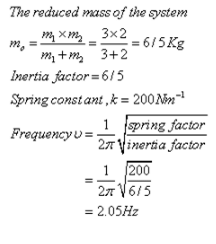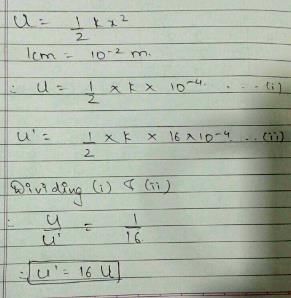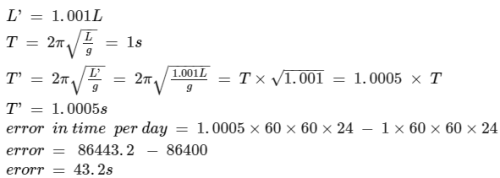All Exams >
NEET >
NCERT Based Tests for NEET >
All Questions
All questions of Oscillations for NEET Exam
Find the amplitude of the S.H.M whose displacement y in cm is given by equation y= 3sin 157t +4cos157t where t is time in seconds.- a)20Hz
- b)25Hz
- c)50Hz
- d)40Hz
Correct answer is option 'B'. Can you explain this answer?
Find the amplitude of the S.H.M whose displacement y in cm is given by equation y= 3sin 157t +4cos157t where t is time in seconds.
a)
20Hz
b)
25Hz
c)
50Hz
d)
40Hz

|
Pioneer Academy answered |
When the displacement of a SHM is:
y=a sin wt+ b cos wt
y=a sin wt+ b cos wt
- Amplitude of the SHM will be:
A=√a2+b2
Here, a = 3, b = 4
Amplitude, A= √(32+42) = 5 cm
Amplitude, A= √(32+42) = 5 cm
Hence option B is correct.
A sound source of frequency 600 Hz is moving towards an observer with velocity 20m/s. The speed of sound is 340m/s. The frequency heard by observer will be- a)630.5hz
- b)30hz
- c)637.5hz
- d)63.5 Hz
Correct answer is option 'C'. Can you explain this answer?
A sound source of frequency 600 Hz is moving towards an observer with velocity 20m/s. The speed of sound is 340m/s. The frequency heard by observer will be
a)
630.5hz
b)
30hz
c)
637.5hz
d)
63.5 Hz
|
|
Preeti Khanna answered |
F(s)/F(l) = [V+V(s)]/[V+V(l)]
V = velocity of sound = 340m/s
V(l) = velocity of listener = 0
F(l) = frequency heard by listener = ?
V(s) = velocity of source = -20m/s (because, it's source to listener)
F(s) = frequency of source = 600hz
By putting these values in the above formula and solving we get,
F(l) = 637.5 Hz.
Hence C is correct.
V = velocity of sound = 340m/s
V(l) = velocity of listener = 0
F(l) = frequency heard by listener = ?
V(s) = velocity of source = -20m/s (because, it's source to listener)
F(s) = frequency of source = 600hz
By putting these values in the above formula and solving we get,
F(l) = 637.5 Hz.
Hence C is correct.
Two identical spring, each of stiffness k are welded to each other at point P. The other two ends are fixed to the edge of a smooth horizontal tube as shown. A particle of mass m is welded at P. The entire system is horizontal. The period of oscillation of the particle in the direction of x is 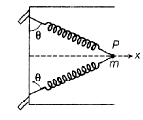
- a)

- b)

- c)

- d)

Correct answer is option 'D'. Can you explain this answer?
Two identical spring, each of stiffness k are welded to each other at point P. The other two ends are fixed to the edge of a smooth horizontal tube as shown. A particle of mass m is welded at P. The entire system is horizontal. The period of oscillation of the particle in the direction of x is 
a)
b)
c)
d)

|
Mohit Rajpoot answered |
Let us assume a force dF is applied at P in positive x - direction. This will stretch each spring by dl inducing a spring force dFs in each spring.
Let the static deformation of the system is dx (along the x-direction). The particle is in equilibrium. So,
Using Pythagoras theorem,
Here y is constant.
A second pendulum is mounted in a space shuttle. Its period of oscillations will decrease when rocket is- a)moving in geostationary orbit
- b)ascending up with uniform acceleration
- c)descending down with uniform acceleration
- d)moving up with uniform velocity
Correct answer is option 'B'. Can you explain this answer?
A second pendulum is mounted in a space shuttle. Its period of oscillations will decrease when rocket is
a)
moving in geostationary orbit
b)
ascending up with uniform acceleration
c)
descending down with uniform acceleration
d)
moving up with uniform velocity

|
Top Rankers answered |
- Time Period, T = 2π √(l/g')where,
l = Length of seconds pendulum
g’ = Apparent Gravity - For the period of oscillations of Seconds Pendulum to decrease, the Apparent gravity (g’) has to increase because:

- Hence, Time Period of oscillations of Seconds Pendulum will decrease when the rocket is ascending up with uniform acceleration.
What is the maximum Kinetic energy and minimum potential energy of a harmonic oscillator with amplitude 0.03m, force constant 4×105 N/m and total mechanical energy of 230 J.- a)200J, 40J
- b)180J,50J
- c)190J, 60J
- d)210J,60J
Correct answer is option 'B'. Can you explain this answer?
What is the maximum Kinetic energy and minimum potential energy of a harmonic oscillator with amplitude 0.03m, force constant 4×105 N/m and total mechanical energy of 230 J.
a)
200J, 40J
b)
180J,50J
c)
190J, 60J
d)
210J,60J

|
Infinity Academy answered |
K. Σ=1/2 K(A2-x2)
Max of mean position,
K. Σ=1/2 KA2
=1/2 x4x105x(3x10-2)2
=180J
T.M. Σ=180+P.Σ
230=180+P.Σ
P.Σ=230-180
P.Σ=50J
Max of mean position,
K. Σ=1/2 KA2
=1/2 x4x105x(3x10-2)2
=180J
T.M. Σ=180+P.Σ
230=180+P.Σ
P.Σ=230-180
P.Σ=50J
If a simple pendulum oscillates with an amplitude 50 mm and time period 2s, then its maximum velocity isa)0.15 m/sb)0.1 m/sc)0.16 m/sd)0.8 m/sCorrect answer is option 'A'. Can you explain this answer?
|
|
Neha Joshi answered |
We know that in a simple harmonic motion the maximum velocity,
Vmax = A⍵
Here A = 50 mm
Vmax = A⍵
Here A = 50 mm
And ⍵ = 2π / T
= 2π / 2
= π
= 2π / 2
= π
Hence Vmax = 50 x 10-3.π
= 0.15 m/s
= 0.15 m/s
Phenomenon of beats is not used in- a)Tuning musical instruments
- b)Detecting the presence of dangerous gases in mines
- c)Designing low frequency oscillators
- d)Radars for detecting submarines
Correct answer is option 'D'. Can you explain this answer?
Phenomenon of beats is not used in
a)
Tuning musical instruments
b)
Detecting the presence of dangerous gases in mines
c)
Designing low frequency oscillators
d)
Radars for detecting submarines

|
Top Rankers answered |
Radar uses electromagnetic energy pulses. The radio-frequency (rf) energy is transmitted to and reflected from the reflecting object. A small portion of the reflected energy returns to the radar set. This returned energy is called an ECHO. Radar sets use the echo to determine the direction and distance of the reflecting object.
It does not work on phenomena of beats.
It does not work on phenomena of beats.
If the length of a simple pendulum is increases by 1percent, then the new time-period
a) Decreases by 0.5 percent
b) Increases by 0.5 percent
c) Increases by 1 percent
d) Increases by 2.0 percent
Correct answer is option 'B'. Can you explain this answer?
|
|
Krishna Iyer answered |
Time period, T=2π√l/g
=>T∝√l
=>ΔT/T=1/2 Δl/l
Δl/l=1%
Therefore, ΔT/T=1/2x1%=0.5%
=>T∝√l
=>ΔT/T=1/2 Δl/l
Δl/l=1%
Therefore, ΔT/T=1/2x1%=0.5%
As a wave propagates; which of the following is not satisfied?- a)the wave intensity remains constant for a plane wave
- b)total intensity of the spherical wave over the spherical surface centered at the source remains constant at all times
- c)the wave intensity decreases as the inverse of the square of the distance from the source for a spherical wave
- d)the wave intensity decreases as the inverse of the distance from the source for a spherical wave
Correct answer is option 'D'. Can you explain this answer?
As a wave propagates; which of the following is not satisfied?
a)
the wave intensity remains constant for a plane wave
b)
total intensity of the spherical wave over the spherical surface centered at the source remains constant at all times
c)
the wave intensity decreases as the inverse of the square of the distance from the source for a spherical wave
d)
the wave intensity decreases as the inverse of the distance from the source for a spherical wave
|
|
Shatabdi Malik answered |
I think it's ans is C.
The work done by the string of a simple pendulum in S.H.M is- a)zero
- b)equal to total energy of system
- c)mg
- d)equal to kinetic energy of the system
Correct answer is option 'A'. Can you explain this answer?
The work done by the string of a simple pendulum in S.H.M is
a)
zero
b)
equal to total energy of system
c)
mg
d)
equal to kinetic energy of the system

|
Dilip Chaurasiya answered |
Zero becz. Tension and disp. Is at 90 degree.
Pure sound notes from two sources make the molecules of air at a location vibrate simple harmonically in accordance with the equations.
y1 = 0.008 sin (604 n t) and
y2 = 0.007 sin (610 n t) respectively.
The number of beast heard by a person at the location will be:- a)3
- b)1
- c)2
- d)4
Correct answer is option 'A'. Can you explain this answer?
Pure sound notes from two sources make the molecules of air at a location vibrate simple harmonically in accordance with the equations.
y1 = 0.008 sin (604 n t) and
y2 = 0.007 sin (610 n t) respectively.
The number of beast heard by a person at the location will be:
y1 = 0.008 sin (604 n t) and
y2 = 0.007 sin (610 n t) respectively.
The number of beast heard by a person at the location will be:
a)
3
b)
1
c)
2
d)
4

|
Tarun Kaushik answered |
Given that two sources produce pure sound notes as follows: y1= 0.008 sin (604 n t) y2= 0.007 sin (610 n t) To find the number of beats heard by a person at the location, we need to first understand the concept of beats.
Beats: When two sound waves of slightly different frequencies are superimposed, we hear a periodic variation in the loudness of sound. This variation is called beats.
The number of beats heard per second is given by the difference between the frequencies of the two sound waves.
Mathematically, the beat frequency is given by fbeat = |f1 - f2| where f1 and f2 are the frequencies of the two sound waves. In this problem, the frequencies of the two sound waves are 604 n and 610 n, respectively.
Therefore, the beat frequency is fbeat = |604 n - 610 n| = 6 n Since the beat frequency is 6 n, the number of beats heard per second is 6. Since each beat corresponds to two sound waves (one from each source), the total number of sound waves heard per second is twice the number of beats, which is 12.
However, the question asks for the number of distinct sounds heard, which is equal to the number of beats. Therefore, the answer is 3 (Option A).
What will be the phase difference between bigger pendulum (with time period 5T/4 )and smaller pendulum (with time period T) after one oscillation of bigger pendulum?- a)π/4
- b)π/2
- c)π/3
- d)π
Correct answer is option 'B'. Can you explain this answer?
What will be the phase difference between bigger pendulum (with time period 5T/4 )and smaller pendulum (with time period T) after one oscillation of bigger pendulum?
a)
π/4
b)
π/2
c)
π/3
d)
π
|
|
Preeti Iyer answered |
By the time bigger pendulum completes one vibration, the smaller pendulum would have completed 5/4 vibrations. That is smaller pendulum will be ahead by 1/4 vibration in phase. 1/4 vibration means λ/4 path or π/2 radians.
The dimensions and unit of phase constant Φ is- a)dinensionless,rad
- b)[T]-1 ,s-1
- c)dinensionless, no units
- d)[T] , s
Correct answer is option 'A'. Can you explain this answer?
The dimensions and unit of phase constant Φ is
a)
dinensionless,rad
b)
[T]-1 ,s-1
c)
dinensionless, no units
d)
[T] , s
|
|
Suresh Reddy answered |
Mathematical constants don't have any dimensions hence, it is dimensionless and phase constant is in angle therefore, the unit is radian.
A frequency of 1Hz corresponds to:- a)2 vibrations per second
- b)1 vibration per second
- c)10 vibrations per second
- d)a time period of ½ second
Correct answer is option 'B'. Can you explain this answer?
A frequency of 1Hz corresponds to:
a)
2 vibrations per second
b)
1 vibration per second
c)
10 vibrations per second
d)
a time period of ½ second
|
|
Alok Mehta answered |
Frequency used to be measured in cycles per second, but now we use the unit of frequency - the Hertz (abbreviated Hz). One Hertz (1Hz) is equal to one vibration per second. So the weight above is bouncing with a frequency of about 1Hz. The sound wave corresponding to Middle C on a piano is around 256Hz.
What determines the natural frequency of a body?- a)Position of the body with respect to force applied
- b)Mass and speed of the body
- c)Oscillations in the body
- d)Elastic properties and dimensions of the body
Correct answer is option 'D'. Can you explain this answer?
What determines the natural frequency of a body?
a)
Position of the body with respect to force applied
b)
Mass and speed of the body
c)
Oscillations in the body
d)
Elastic properties and dimensions of the body
|
|
Lavanya Menon answered |
Natural frequency is the frequency at which a body tends to oscillate in the absence of any driving or damping force.
Free vibrations of any elastic body are called natural vibration and happen at a frequency called natural frequency. Natural vibrations are different from forced vibration which happen at frequency of applied force .
Free vibrations of any elastic body are called natural vibration and happen at a frequency called natural frequency. Natural vibrations are different from forced vibration which happen at frequency of applied force .
A mass m = 2.0 kg is attached to a spring having a force constant k = 290 N/m as in the figure. The mass is displaced from its equilibrium position and released. Its frequency of oscillation (in Hz) is approximately:

- a)12
- b)0.50
- c)1.9
- d)0.01
Correct answer is option 'C'. Can you explain this answer?
A mass m = 2.0 kg is attached to a spring having a force constant k = 290 N/m as in the figure. The mass is displaced from its equilibrium position and released. Its frequency of oscillation (in Hz) is approximately:


a)
12
b)
0.50
c)
1.9
d)
0.01
|
|
Riya Banerjee answered |
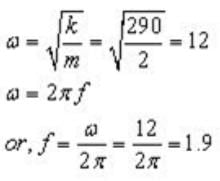
A particle executes linear simple harmonic motion with an amplitude of 2 cm. When the particle is at 1 cm from the mean position, the magnitude of its velocity is equal to that of its acceleration. Then its time period in seconds is:- a)2π/√3
- b)2π√3
- c)√3/2π
- d)1/ 2π√3
Correct answer is option 'A'. Can you explain this answer?
A particle executes linear simple harmonic motion with an amplitude of 2 cm. When the particle is at 1 cm from the mean position, the magnitude of its velocity is equal to that of its acceleration. Then its time period in seconds is:
a)
2π/√3
b)
2π√3
c)
√3/2π
d)
1/ 2π√3
|
|
Jyoti Kapoor answered |
velocity at distance x in shm is given as
v= w sqrt(A2-x2)
so A = 2 x =1
v = w sqrt(4-1) = wsqrt3
now acc at distance x is a= w2 x = w2
as mag a = mag v
w2 = wsqrt3
w= sqrt3
2pi/T= sqrt3
T = 2pi/sqrt3
If  is the natural frequency of the system and
is the natural frequency of the system and  is the frequency of the external force that acts on an oscillating system then at resonance
is the frequency of the external force that acts on an oscillating system then at resonance- a)ωd ≥ ω
- b)ωd = ω
- c)ωd ≤ ω
- d)ωd ≠ ω
Correct answer is option 'B'. Can you explain this answer?
If  is the natural frequency of the system and
is the natural frequency of the system and  is the frequency of the external force that acts on an oscillating system then at resonance
is the frequency of the external force that acts on an oscillating system then at resonance
 is the natural frequency of the system and
is the natural frequency of the system and  is the frequency of the external force that acts on an oscillating system then at resonance
is the frequency of the external force that acts on an oscillating system then at resonancea)
ωd ≥ ω
b)
ωd = ω
c)
ωd ≤ ω
d)
ωd ≠ ω
|
|
Om Desai answered |
When the natural frequency and external frequency of an object are equal the phenomenon is called resonance.
If the period of oscillation of mass M suspended from a spring is one second, then the period of mass 4 M will be- a)1/ 4s
- b)4s
- c)1/ 2s
- d)2s
Correct answer is option 'D'. Can you explain this answer?
If the period of oscillation of mass M suspended from a spring is one second, then the period of mass 4 M will be
a)
1/ 4s
b)
4s
c)
1/ 2s
d)
2s
|
|
Geetika Shah answered |
T=2*3.14*√m/√k=1 s (given)
T’=2*3.14*√4m/√k=2*3.14*2√m/√k=2*1s
Therefore T’=2s
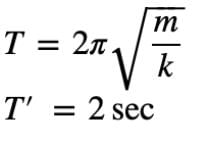

The restoring force in a simple harmonic motion is _________ in magnitude when the particle is instantaneously at rest.- a)zero
- b)maximum
- c)minimum
- d)none of these
Correct answer is option 'B'. Can you explain this answer?
The restoring force in a simple harmonic motion is _________ in magnitude when the particle is instantaneously at rest.
a)
zero
b)
maximum
c)
minimum
d)
none of these

|
Knowledge Hub answered |
The restoring force in a simple harmonic motion is maximum in magnitude when the particle is instantaneously at rest because in SHM object’s tendency is to return to mean position and here particle is instantaneously at rest after that instant restoring force will be max to bring particle to mean position.
The amplitude A of a simple harmonic oscillator (with period, T and energy, E) is tripled. What would happen to T and E?
- a)T and E triples
- b)T and E doubles
- c)T remains same and E becomes nine times
- d)T gets tripled and E becomes zero
Correct answer is option 'C'. Can you explain this answer?
The amplitude A of a simple harmonic oscillator (with period, T and energy, E) is tripled. What would happen to T and E?
a)
T and E triples
b)
T and E doubles
c)
T remains same and E becomes nine times
d)
T gets tripled and E becomes zero
|
|
Preeti Iyer answered |
E α A2 and hence the energy will become 9 times.
T is independent of A and hence no change will occur.
Hence C is the correct answer.
T is independent of A and hence no change will occur.
Hence C is the correct answer.
A body of mass 5.0 kg is suspended by a spring which stretches 10 cm when the mass is attached. It is then displaced downward an additional 5.0 cm and released. Its position as a function of time is approximately:- a)y = .10 cos (9.9t + .1)
- b)y = .10 sin 9.9t
- c)y = .10 cos 9.9t
- d)y = .05 cos 9.9t
Correct answer is option 'D'. Can you explain this answer?
A body of mass 5.0 kg is suspended by a spring which stretches 10 cm when the mass is attached. It is then displaced downward an additional 5.0 cm and released. Its position as a function of time is approximately:
a)
y = .10 cos (9.9t + .1)
b)
y = .10 sin 9.9t
c)
y = .10 cos 9.9t
d)
y = .05 cos 9.9t
|
|
Nandini Iyer answered |
a. y
= .10 sin 9.9t
b. y
= .10 cos 9.9t
c. y
= .10 cos (9.9t + .1)
d. y
= .10 sin (9.9t + 5)
e. y
= .05 cos 9.9t
Answer: e.
y = 0.5 . cos 9.9 t
If an external force with angular frequency ωd acts on an oscillating system with natural angular frequency ω, the system oscillates with angular frequency ωd. The amplitude of oscillations is the greatest when:- a)ωd > ω
- b)ωd < ω
- c)ωd ≥ ω
- d)ωd = ω
Correct answer is option 'D'. Can you explain this answer?
If an external force with angular frequency ωd acts on an oscillating system with natural angular frequency ω, the system oscillates with angular frequency ωd. The amplitude of oscillations is the greatest when:
a)
ωd > ω
b)
ωd < ω
c)
ωd ≥ ω
d)
ωd = ω
|
|
Jyoti Aiims Aspirant answered |
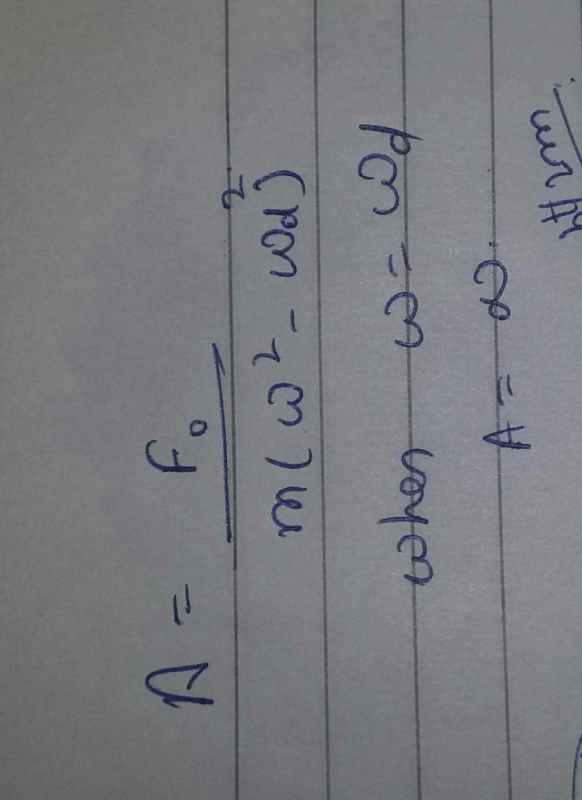
If the sign in equation F = -kx is changed what would happen to the motion of the oscillating body?- a)Motion would be linearly accelerated motion
- b)Body would come at rest
- c)Body would slow down
- d)Motion would be oscillating accelerated
Correct answer is option 'A'. Can you explain this answer?
If the sign in equation F = -kx is changed what would happen to the motion of the oscillating body?
a)
Motion would be linearly accelerated motion
b)
Body would come at rest
c)
Body would slow down
d)
Motion would be oscillating accelerated

|
Imk Pathsala answered |
If the sign is changed in F=-kx then the force and hence acceleration will not be opposite to the displacement. Due to this the particle will not oscillate and would accelerate in the direction of displacement. Hence the motion of the body will become linearly accelerated motion.
When two tuning forks are sounded together 4 beats are heard per second. One tuning fork is of frequency 346 Hz. When its prong is loaded with a little wax, the number of beats is increased to 6 per second. The frequency of the other fork is:- a)352 Hz
- b)340 Hz
- c)350 Hz
- d)342 Hz
Correct answer is option 'C'. Can you explain this answer?
When two tuning forks are sounded together 4 beats are heard per second. One tuning fork is of frequency 346 Hz. When its prong is loaded with a little wax, the number of beats is increased to 6 per second. The frequency of the other fork is:
a)
352 Hz
b)
340 Hz
c)
350 Hz
d)
342 Hz
|
|
Suresh Reddy answered |
Frequency of fork one is 346 Hz.
When the other fork is waxed, the beat is increased.
So, the frequency of other fork is less than the frequency of fork one.
So,
beat = frequency of fork one − frequency of second fork
4=346− Frequency of second fork
Frequency of second fork =350 Hz
When the other fork is waxed, the beat is increased.
So, the frequency of other fork is less than the frequency of fork one.
So,
beat = frequency of fork one − frequency of second fork
4=346− Frequency of second fork
Frequency of second fork =350 Hz
Under what condition angular frequency ω of the damped oscillator would be equivalent to angular velocity Ω of the undamped oscillator.- a)Velocity of oscillator is small
- b)Damping constant, b is small
- c)Damping constant ,b is large
- d)Force applied is small
Correct answer is option 'B'. Can you explain this answer?
Under what condition angular frequency ω of the damped oscillator would be equivalent to angular velocity Ω of the undamped oscillator.
a)
Velocity of oscillator is small
b)
Damping constant, b is small
c)
Damping constant ,b is large
d)
Force applied is small
|
|
Priya Patel answered |
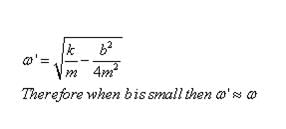
To the nearest order of magnitude, how many times greater than the speed of sound is the speed of light?- a)104
- b)1012
- c)108
- d)106
Correct answer is option 'D'. Can you explain this answer?
To the nearest order of magnitude, how many times greater than the speed of sound is the speed of light?
a)
104
b)
1012
c)
108
d)
106
|
|
Lavanya Menon answered |
Speed of sound in air is 343 m/s or we can say approx 300m/s
And speed of light is approx 300,000,000 m/s
Clearly the ratio is 106
And speed of light is approx 300,000,000 m/s
Clearly the ratio is 106
A particle of mass 0.1 kg is executing SHM of amplitude 0.1 m. When the particle passes through the mean position, its KE is 8 ×10-3 J. Find the equation of motion of the particle if the initial phase of oscillation is 45˚- a)y = 0.1 cos(3t + (π/4))
- b)y = 0.1 sin(6t + (π/4))
- c)y = 0.1 sin(4t + (π/4))
- d)y=0.1 cos(4t + (π/4))
Correct answer is option 'C'. Can you explain this answer?
A particle of mass 0.1 kg is executing SHM of amplitude 0.1 m. When the particle passes through the mean position, its KE is 8 ×10-3 J. Find the equation of motion of the particle if the initial phase of oscillation is 45˚
a)
y = 0.1 cos(3t + (π/4))
b)
y = 0.1 sin(6t + (π/4))
c)
y = 0.1 sin(4t + (π/4))
d)
y=0.1 cos(4t + (π/4))

|
Trisha Vashisht answered |
According to question
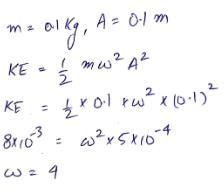
By substituting the value we the final equation


By substituting the value we the final equation

A simple pendulum with length l and bob of mass m is executing S.H.M of small amplitude a. The expression for maximum tension in the string will be- a)mg
- b)

- c)

- d)mg[1 + (a/l) ]
Correct answer is option 'B'. Can you explain this answer?
A simple pendulum with length l and bob of mass m is executing S.H.M of small amplitude a. The expression for maximum tension in the string will be
a)
mg
b)
c)
d)
mg[1 + (a/l) ]
|
|
Nandini Patel answered |
The tension in the string would be maximum when bob will be passing mean position.
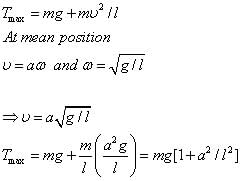

What provides the restoring force for SHM in case of column of mercury in U-tube?- a)Temperature
- b)Weight of mercury
- c)Height of column
- d)Elasticity
Correct answer is option 'B'. Can you explain this answer?
What provides the restoring force for SHM in case of column of mercury in U-tube?
a)
Temperature
b)
Weight of mercury
c)
Height of column
d)
Elasticity
|
|
Riya Banerjee answered |
Weight of mercury provides the restoring force for SHM in case of column of mercury in U-tube.
A rubber ball with water, having a small hole in its bottom is used as the bob of a simple pendulum. The time-period of such a pendulum:- a)Increases with time
- b)First increases and then decreases finally having same value as at the beginning
- c)Decreases with time
- d)Is a constant
Correct answer is option 'B'. Can you explain this answer?
A rubber ball with water, having a small hole in its bottom is used as the bob of a simple pendulum. The time-period of such a pendulum:
a)
Increases with time
b)
First increases and then decreases finally having same value as at the beginning
c)
Decreases with time
d)
Is a constant
|
|
Rajesh Gupta answered |
When rubber ball completely filled with water its centre of gravity will be at its centre, as water will fall through hole its COG will shift towards lower side leading to increase in length of pendulum and thus T, when very small amount of water will be left in rubber ball its COG will again shifts upward causing decrease in length and thus T, and finally when rubber ball becomes empty its COG will be at its centre and T will remains same as earlier.
Whose motion is an ideal case of SHM?- a)An electric dipole placed stably in a uniform electric field and then given a very small regular displacement
- b)A simple pendulum with very small angle of swing
- c)Shadow of a point mass having uniform circular motion, on the vertical diameter
- d)none
Correct answer is option 'A'. Can you explain this answer?
Whose motion is an ideal case of SHM?
a)
An electric dipole placed stably in a uniform electric field and then given a very small regular displacement
b)
A simple pendulum with very small angle of swing
c)
Shadow of a point mass having uniform circular motion, on the vertical diameter
d)
none
|
|
Raghav Bansal answered |
Simple pendulum is not a case of ideal SHM as it is mention in NCERT.
Shadow of a point mass having uniform circular motion on the horizontal diameter is a case of SHM but not on the vertical diameter.
Shadow of a point mass having uniform circular motion on the horizontal diameter is a case of SHM but not on the vertical diameter.
If a source of sound was moving toward a receiver at 1/3 the speed of sound, what would the resulting wavelength be?- a)6 times the emitted wavelength
- b)2/3 of the emitted wavelength
- c)1/3 of the emitted wavelength
- d)Can not be found
Correct answer is option 'B'. Can you explain this answer?
If a source of sound was moving toward a receiver at 1/3 the speed of sound, what would the resulting wavelength be?
a)
6 times the emitted wavelength
b)
2/3 of the emitted wavelength
c)
1/3 of the emitted wavelength
d)
Can not be found

|
Ambition Institute answered |
We need to find the resulting wavelength of the sound wave, which can be calculated using the formula: λ' = λ(v +/- vs) / (v + u) Since the source is moving towards the observer, we can use the negative sign for vs: λ' = λ(v - vs) / (v + u) λ' = λ(v - (-1/3)v) / (v + u) λ' = λ(4/3v) / (v + u) We can also use the formula for the speed of the sound wave: v = fλ which gives us: λ = v/f Substituting this value in the above equation, we get: λ' = (4/3)(v/f) / (v + u) λ' = (4/3)f / (3v + u) We know that the velocity of the observer (u) is zero since it is stationary. Thus, the equation simplifies to: λ' = (4/9)f/v This means that the resulting wavelength is 2/3 of the emitted wavelength since: λ' / λ = (4/9f/v) / (f/v) = 4/9 = 0.44 Therefore, the correct answer is option B, 2/3 of the emitted wavelength.
Waves associated with moving protons, electrons, neutrons, atoms are known as- a)none of these
- b)Gamma rays
- c)Matter waves
- d)Electromagnetic waves
Correct answer is option 'C'. Can you explain this answer?
Waves associated with moving protons, electrons, neutrons, atoms are known as
a)
none of these
b)
Gamma rays
c)
Matter waves
d)
Electromagnetic waves

|
Vik. Singh answered |
If they are associated with matter waves then what about electromagnetic waves..?
... I'm so confused now :(
Two harmonic waves traveling on a string in the same direction both have a frequency of 100 Hz, a wavelenqth of 2.0cm, and amplitude of 0.020 m. In addition, they overlap each other. What is the amplitude of the resultant wave if the original waves differ in phase by Syntax error from line 1 column 49 to line 1 column 73. Unexpected ‘mathsize’./6?- a)3.5 cm
- b)4.2 cm
- c)3.7 cm
- d)3.9 cm
Correct answer is option 'D'. Can you explain this answer?
Two harmonic waves traveling on a string in the same direction both have a frequency of 100 Hz, a wavelenqth of 2.0cm, and amplitude of 0.020 m. In addition, they overlap each other. What is the amplitude of the resultant wave if the original waves differ in phase by Syntax error from line 1 column 49 to line 1 column 73. Unexpected ‘mathsize’./6?
a)
3.5 cm
b)
4.2 cm
c)
3.7 cm
d)
3.9 cm
|
|
Rajeev Nair answered |
Question:
Two harmonic waves traveling on a string in the same direction both have a frequency of 100 Hz, a wavelength of 2.0 cm, and amplitude of 0.020 m. In addition, they overlap each other. What is the amplitude of the resultant wave if the original waves differ in phase by 6π?
Solution:
Given parameters:
Frequency of each wave = 100 Hz
Wavelength of each wave = 2.0 cm
Amplitude of each wave = 0.020 m
Phase difference between the waves = 6π
To find: Amplitude of the resultant wave
We know that the displacement of a wave is given by the equation:
y = A sin(kx - ωt + φ)
where, A = amplitude of the wave, k = wave number, x = position, ω = angular frequency, t = time, and φ = phase constant.
For two waves with the same frequency and wavelength traveling in the same direction, the wave number and angular frequency are the same, and the displacement equation becomes:
y1 = A sin(kx - ωt + φ1)
y2 = A sin(kx - ωt + φ2)
where, φ1 and φ2 are the phase constants of the two waves.
The resultant wave is obtained by adding the two waves:
y = y1 + y2
= A sin(kx - ωt + φ1) + A sin(kx - ωt + φ2)
= 2A cos((φ1 - φ2)/2) sin(kx - ωt + (φ1 + φ2)/2)
where, cos((φ1 - φ2)/2) is the amplitude of the resultant wave.
Given that the phase difference between the waves is 6π, we have:
φ1 - φ2 = 6π
cos((φ1 - φ2)/2) = cos(3π) = -1
Substituting the given values, we get:
Amplitude of the resultant wave = 2(0.020) (-1) = -0.040 m
However, amplitude is always positive, so we take the absolute value:
Amplitude of the resultant wave = 0.040 m
Therefore, the amplitude of the resultant wave is 0.040 m.
Two harmonic waves traveling on a string in the same direction both have a frequency of 100 Hz, a wavelength of 2.0 cm, and amplitude of 0.020 m. In addition, they overlap each other. What is the amplitude of the resultant wave if the original waves differ in phase by 6π?
Solution:
Given parameters:
Frequency of each wave = 100 Hz
Wavelength of each wave = 2.0 cm
Amplitude of each wave = 0.020 m
Phase difference between the waves = 6π
To find: Amplitude of the resultant wave
We know that the displacement of a wave is given by the equation:
y = A sin(kx - ωt + φ)
where, A = amplitude of the wave, k = wave number, x = position, ω = angular frequency, t = time, and φ = phase constant.
For two waves with the same frequency and wavelength traveling in the same direction, the wave number and angular frequency are the same, and the displacement equation becomes:
y1 = A sin(kx - ωt + φ1)
y2 = A sin(kx - ωt + φ2)
where, φ1 and φ2 are the phase constants of the two waves.
The resultant wave is obtained by adding the two waves:
y = y1 + y2
= A sin(kx - ωt + φ1) + A sin(kx - ωt + φ2)
= 2A cos((φ1 - φ2)/2) sin(kx - ωt + (φ1 + φ2)/2)
where, cos((φ1 - φ2)/2) is the amplitude of the resultant wave.
Given that the phase difference between the waves is 6π, we have:
φ1 - φ2 = 6π
cos((φ1 - φ2)/2) = cos(3π) = -1
Substituting the given values, we get:
Amplitude of the resultant wave = 2(0.020) (-1) = -0.040 m
However, amplitude is always positive, so we take the absolute value:
Amplitude of the resultant wave = 0.040 m
Therefore, the amplitude of the resultant wave is 0.040 m.
In the figure shown pulley is massless. Initially the blocks are held at a height such that spring is in its natural length. The amplitude and velocity amplitude of block B1 respectively are (there is no slipping anywhere)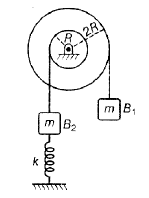
- a)

- b)

- c)

- d)

Correct answer is option 'A'. Can you explain this answer?
In the figure shown pulley is massless. Initially the blocks are held at a height such that spring is in its natural length. The amplitude and velocity amplitude of block B1 respectively are (there is no slipping anywhere)
a)
b)
c)
d)

|
Muskaan Mishra answered |
Decrease in GPE of B1 = Increase in Gravitational PE of B2 + Increase in elastic PE of spring.
Again applying law of conservation of mechanical energy at the mean position we get
The motion of simple pendulum is said to be S.H.M when its angle θ¸ through which bob is displaced from its equilibrium position is- a)θ is very small
- b)θ is zero
- c)θ is very large
- d)θ = cosθ
Correct answer is option 'A'. Can you explain this answer?
The motion of simple pendulum is said to be S.H.M when its angle θ¸ through which bob is displaced from its equilibrium position is
a)
θ is very small
b)
θ is zero
c)
θ is very large
d)
θ = cosθ
|
|
Priya Patel answered |
Consider a simple pendulum having mass 'm', length L and displaced by a small angle Θ with the vertical. Thus, it oscillates about its mean position. In the displaced position, two forces are acting on the bob, Gravitational force, which is the weight of the bob – 'mg' acting in the downward direction.
A particle starts S.H.M. from the mean position. Its amplitude is A and time period is T. At the time when its speed is half of the maximum speed, its displacement y is- a)A√3/2
- b)2A/√3
- c)A/2
- d)A/√2
Correct answer is option 'A'. Can you explain this answer?
A particle starts S.H.M. from the mean position. Its amplitude is A and time period is T. At the time when its speed is half of the maximum speed, its displacement y is
a)
A√3/2
b)
2A/√3
c)
A/2
d)
A/√2
|
|
Rajesh Gupta answered |
The relation between angular frequency and displacement is given as
v=ω√A2−x2
Suppose
x=A sinω t
On differentiating the above equation w.r.t. time we get
dx/dt=Aωcosωt
The maximum value of velocity will be [{v{\max }} = A\omega \]
The displacement for the time when speed is half the maximum is given as
v=Aω/2
A2ω2=4ω(A2−x2)
By substituting the value in (1) we get the displacement as
x=A√3/2
v=ω√A2−x2
Suppose
x=A sinω t
On differentiating the above equation w.r.t. time we get
dx/dt=Aωcosωt
The maximum value of velocity will be [{v{\max }} = A\omega \]
The displacement for the time when speed is half the maximum is given as
v=Aω/2
A2ω2=4ω(A2−x2)
By substituting the value in (1) we get the displacement as
x=A√3/2
Damping is due to- a)electrostatic forces
- b)resistive forces like air drag, friction etc.
- c)reaction forces
- d)conservative forces like gravity
Correct answer is option 'B'. Can you explain this answer?
Damping is due to
a)
electrostatic forces
b)
resistive forces like air drag, friction etc.
c)
reaction forces
d)
conservative forces like gravity
|
|
Om Desai answered |
Damping is due to resistive forces like air drag, friction etc.
If the reference particle P moves in uniform circular motion, its projection along a diameter of the circle executes- a)motion along x axis
- b)motion along y axis
- c)circular motion
- d)Simple Harmonic motion
Correct answer is option 'D'. Can you explain this answer?
If the reference particle P moves in uniform circular motion, its projection along a diameter of the circle executes
a)
motion along x axis
b)
motion along y axis
c)
circular motion
d)
Simple Harmonic motion
|
|
Raghav Bansal answered |
SHM is a 1D projection of 2D UCM.
In Doppler effect change in frequency depends on- a)distance between source and listener
- b)speeds of source and listener
- c)density of air
- d)half of distance between source and listener
Correct answer is option 'B'. Can you explain this answer?
In Doppler effect change in frequency depends on
a)
distance between source and listener
b)
speeds of source and listener
c)
density of air
d)
half of distance between source and listener
|
|
Om Desai answered |
The reason for the Doppler effect is that when the source of the waves is moving towards the observer, each successive wave crest is emitted from a position closer to the observer than the crest of the previous wave.
The ratio of maximum acceleration to maximum velocity of a particle performing S.H.M is equal to- a)Square of amplitude
- b)Square of angular velocity
- c)Amplitude
- d)Angular velocity
Correct answer is option 'D'. Can you explain this answer?
The ratio of maximum acceleration to maximum velocity of a particle performing S.H.M is equal to
a)
Square of amplitude
b)
Square of angular velocity
c)
Amplitude
d)
Angular velocity
|
|
Om Desai answered |
Maximum acceleration = w2A
Maximum velocity = wA
Ratio = w2A/wA = w
w = angular velocity
A = amplitude
Maximum velocity = wA
Ratio = w2A/wA = w
w = angular velocity
A = amplitude
Damped natural frequency is- a)same as natural frequency
- b)lower than natural frequency
- c)higher than natural frequency
- d)none of the above
Correct answer is option 'B'. Can you explain this answer?
Damped natural frequency is
a)
same as natural frequency
b)
lower than natural frequency
c)
higher than natural frequency
d)
none of the above
|
|
Geetika Shah answered |
If a resonant mechanical structure is set in motion and left to its own devices, it will continue to oscillate at a particular frequency known as its natural frequency, or "damped natural frequency". This will be a little lower in frequency than the resonant frequency, which is the frequency it would assume if there were no damping. The resonant frequency is also called the "undamped natural frequency”
A radar sends a radio signal of frequency 9 x 109 Hz towards an aircraft approaching the radar. If the reflected wave shows a frequency shift of 3 X 103 Hz, the speed with which the aircraft is approaching the radar in m/s is (velocity of radio signal is 3 X 108 m/s).- a)100
- b)150
- c)50
- d)25
Correct answer is option 'C'. Can you explain this answer?
A radar sends a radio signal of frequency 9 x 109 Hz towards an aircraft approaching the radar. If the reflected wave shows a frequency shift of 3 X 103 Hz, the speed with which the aircraft is approaching the radar in m/s is (velocity of radio signal is 3 X 108 m/s).
a)
100
b)
150
c)
50
d)
25
|
|
Rajesh Gupta answered |
Given:
Frequency of radio signal n=9×10 9Hz
Frequency shift n0=3×103Hz
Velocity of radio signal v=3×108m/s
Frequency shift shown by reflected wave is Shift =n−n
=>n−n=(v+u/v−u)n−n
Shift=(2u/v−u)n
Now, putting the given values in Eq. (i), we get,
3×103=(2u/3×10-8−u)9×109
⇒3×108−u=2u×9×109/3×103
=6u×106
⇒6×106u+u=3×108
u(6×106+1)=3×108
u(6000001)=3×108
u=3×108/6000001=49.999≈50m/s
Frequency of radio signal n=9×10 9Hz
Frequency shift n0=3×103Hz
Velocity of radio signal v=3×108m/s
Frequency shift shown by reflected wave is Shift =n−n
=>n−n=(v+u/v−u)n−n
Shift=(2u/v−u)n
Now, putting the given values in Eq. (i), we get,
3×103=(2u/3×10-8−u)9×109
⇒3×108−u=2u×9×109/3×103
=6u×106
⇒6×106u+u=3×108
u(6×106+1)=3×108
u(6000001)=3×108
u=3×108/6000001=49.999≈50m/s
Chapter doubts & questions for Oscillations - NCERT Based Tests for NEET 2025 is part of NEET exam preparation. The chapters have been prepared according to the NEET exam syllabus. The Chapter doubts & questions, notes, tests & MCQs are made for NEET 2025 Exam. Find important definitions, questions, notes, meanings, examples, exercises, MCQs and online tests here.
Chapter doubts & questions of Oscillations - NCERT Based Tests for NEET in English & Hindi are available as part of NEET exam.
Download more important topics, notes, lectures and mock test series for NEET Exam by signing up for free.

Contact Support
Our team is online on weekdays between 10 AM - 7 PM
Typical reply within 3 hours
|
Free Exam Preparation
at your Fingertips!
Access Free Study Material - Test Series, Structured Courses, Free Videos & Study Notes and Prepare for Your Exam With Ease

 Join the 10M+ students on EduRev
Join the 10M+ students on EduRev
|

|
Create your account for free
OR
Forgot Password
OR
Signup to see your scores
go up
within 7 days!
within 7 days!
Takes less than 10 seconds to signup



